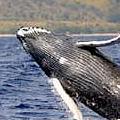 依據美國舊金山地方法院12日核示之協議,未來美國海軍於部份太平洋海域進行軍事訓練時,應嚴禁使用低頻主動聲納系統。
依據美國舊金山地方法院12日核示之協議,未來美國海軍於部份太平洋海域進行軍事訓練時,應嚴禁使用低頻主動聲納系統。
此次由海軍與保育團體兩造共同達成的全面性協議,是依照2008年年初法院頒佈之禁令交涉而成。該禁令旨在限制美國海軍使用拖曳陣列低頻主動聲納探測器監視系統,其利用在浩瀚海底放射猛爆性聲響,監測遠方有無潛艦活動。
法院認同由「自然資源保護委員會」(NRDC)所領導的保育組織聯盟提出的看法,主張海軍於全球70%的海洋部署之低頻主動聲納系統違悖聯邦政策法令。
美國海軍及國防部尚未對低頻主動聲納使用之協議結果做出回應。與此同時,美國海軍的中頻主動聲納使用管制,目前也已進入最高法院司法程序之中。
NRDC高級政策分析家詹斯尼(Michael Jasny)表示:「國防安全與環境保護之間並沒有抉擇的必要性。」「以今日的協議為例,不但兼顧海軍的訓練及戰力,同時亦保護鯨類與其他脆弱物種免受於海底噪音之傷害。」
在此協議下,低頻聲納系統僅限使用於規定之北太平洋海域,海軍並須遵照其他保護性措施,包括季節性和海岸附近的軍事操演空窗,以保護海洋生物的繁殖地與鯨魚的重要棲地。
根據海軍軍方自製之統計,聲納發射後,距源點300哩處之音波強度仍高達140分貝,等於可改變大型鯨魚行為模式音波強度的好幾百倍。科學家們另外也觀察到,在特定海相條件下,單一低頻聲納發出的音波甚至可以傳遍海底各個角落。雖然目前中頻聲納系統最廣為使用,不過一直以來卻也被視為對鯨類的生存帶有殺傷性。
此訴訟案內容堅信,由國家海洋漁業局於2007年同意之全球聲納系統部署,已違反數項聯邦法規,包括「海洋哺乳動物保護法」(Marine Mammal Protection Act)和「國家環境政策法」(National Environmental Policy Act)等。
舊金山地方法院同意上述違法事項並特別指明,聯邦政府無能依法要求,採取適當應變措拖保護海洋生物。該地方法院早於2002年時已指稱放行聲納部署的命令違法,在此之後NRDC與海軍開始進入限制低頻聲納使用之協商程序,直到2007年漁業局發佈放行命令。
The Navy's use of low frequency active sonar will remain limited to certain military training areas of the Pacific Ocean, according to an agreement approved by a U.S. district court in San Francisco today.
The comprehensive agreement between the Navy and conservation organizations follows a court injunction issued early this year against the Navy's Surveillance Towed Array Sensor System Low Frequency Active sonar system, which fills vast ocean areas with blasts of underwater noise to detect submarines at great distances.
The court agreed with a coalition of organizations led by the Natural Resources Defense Council that the Navy's proposed LFA deployment in more than 70 percent of the world's oceans is illegal.
The Navy and the Department of Defense have not yet commented on the low frequency sonar ruling. A separate lawsuit challenging the U.S. Navy's use of mid-frequency active sonar is currently under consideration in the U.S. Supreme Court.
"We don't have to choose between national security and protecting the environment," said Michael Jasny, senior policy analyst with NRDC. "Today's agreement maintains the Navy's ability to test and train, while shielding whales and other vulnerable species from harmful underwater noise."
Under the agreement, LFA testing and training is limited to defined areas of the North Pacific Ocean, and the Navy must adhere to other protective measures, including seasonal and coastal exclusions that will protect breeding grounds and other important whale habitat.
By the Navy's own estimates, even 300 miles from the source these sonic waves can retain an intensity of 140 decibels - a hundred times more intense than the level known to alter the behavior of large whales. Scientists have observed that, under certain oceanic conditions, sound from a single LFA system could be detected across entire oceans. Mid-frequency sonar is more widely used and has been associated with mortalities of whales.
The lawsuit asserted that a permit issued last year by the National Marine Fisheries Service, allowing deployment of the sonar system around the world, violated a number of federal laws including the Marine Mammal Protection Act and the.
The district court agreed, noting in particular that the government had failed to protect marine life with adequate mitigation measures as required by law. In 2002, this same court held a prior permit unlawful, after which NRDC and the Navy entered into a negotiated agreement that restricted LFA training until last year's permit was issued.
全文及圖片詳見ENS




